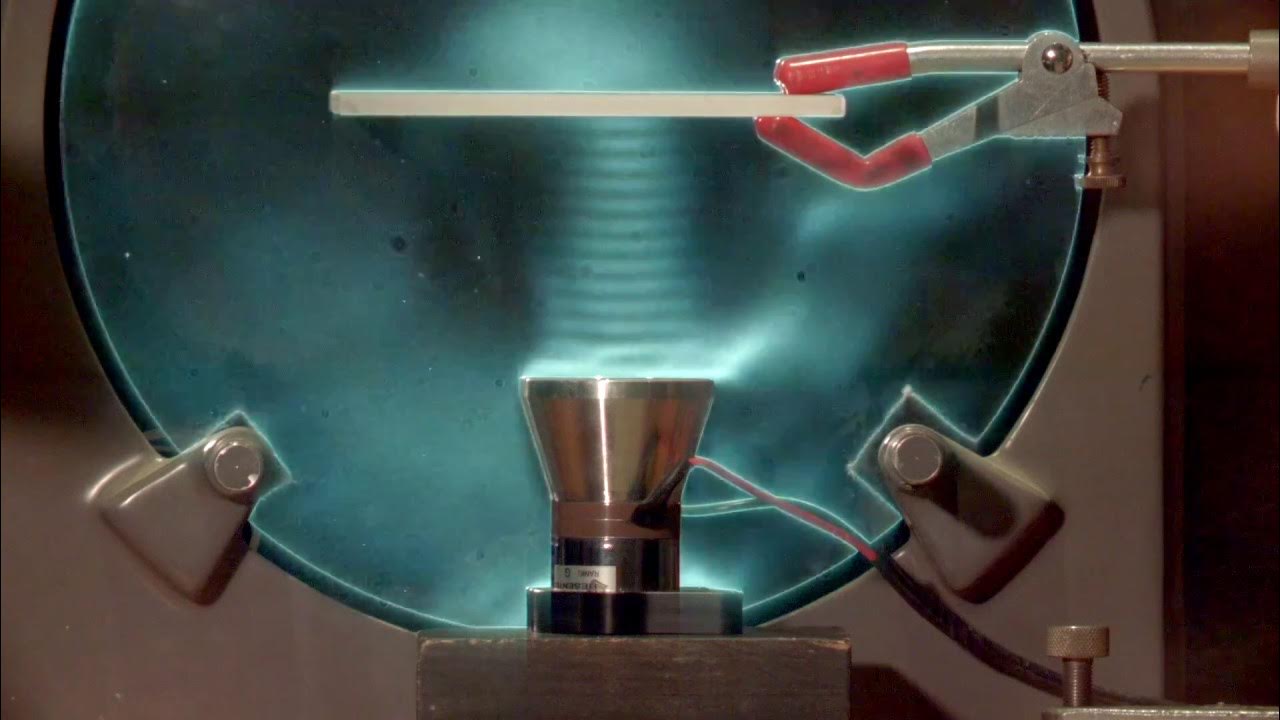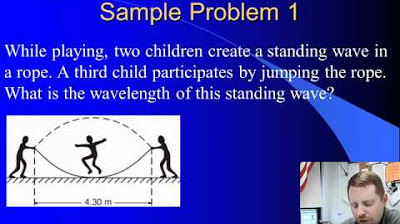How Does Acoustic Levitation Really Work?
TLDRThe video script explains the phenomenon of acoustic levitation, demonstrating how ultrasonic transducers can create standing wave patterns to levitate small objects. It clarifies misconceptions about where objects levitate within the nodes and antinodes of the standing wave, highlighting the roles of ponderomotive force and acoustic radiation pressure. The experiment also explores the effect of vacuum on levitation, showing that sound waves are responsible for the phenomenon. The video concludes with a discussion on the impact of particle size on levitation points, differentiating between large and small particles' behavior within the standing wave.
Takeaways
- 🌐 Acoustic levitation uses ultrasonic sound waves to suspend small objects in mid-air.
- 🔊 The standing wave pattern is created by reflecting sound waves off a surface above an ultrasonic transducer.
- 🚀 Parabolic transducers facilitate easier setup of standing wave patterns, even if the reflector isn't at an exact distance.
- 📈 The levitation effect can be enhanced by using two transducers playing the same wave frequency.
- 💨 A vacuum chamber experiment demonstrates that sound waves are responsible for levitation, as the effect disappears when pressure is reduced.
- 🌊 Sound is a longitudinal wave, creating regions of high and low pressure, unlike transverse waves.
- 🔄 Standing waves are formed when waves reflect back at the right time, creating alternating high and low pressure regions.
- 🔽 Particles typically settle in the nodes of the standing wave due to acoustic radiation pressure.
- 🔜 For very small particles, the ponderomotive force can be stronger, causing them to settle in the antinodes.
- 🌳 The video also promotes an app called Klima, which helps users reduce their carbon footprint and combat climate change.
Q & A
What is acoustic levitation and how does it work?
-Acoustic levitation is a method that uses ultrasonic sound waves to suspend small objects in the air without any physical contact. It works by creating a standing wave pattern between an ultrasonic transducer and a reflector. Objects such as pieces of paper or styrofoam can be placed in the nodes of these standing waves, causing them to levitate due to the pressure differences in the wave.
Why is the setup in the video able to create a standing wave pattern even if the reflector is not at an exact multiple distance from the transducer?
-The setup in the video can create a standing wave pattern easily because the ultrasonic transducer is parabolic. This shape allows it to focus the sound waves, enabling the formation of a standing wave even when the reflector is not at the precise distance that would typically be required for a flat transducer.
How does the vacuum chamber experiment demonstrate that sound waves are responsible for the levitation?
-The vacuum chamber experiment shows that as the pressure inside the chamber decreases, the stability of the levitated objects changes. At a certain point, one of the objects is lost, proving that the levitation is indeed caused by the sound waves, as there is no air in a vacuum to support the particles without the sound waves.
What is the difference between a transverse wave and a longitudinal wave?
-A transverse wave is a type of wave where the displacement of the medium is perpendicular to the direction of the wave's energy transfer, like a wave in a rope. A longitudinal wave, on the other hand, is a type of wave where the displacement of the medium is parallel to the direction of the wave's energy transfer, which is how sound travels through air, with regions of high and low pressure.
What is a standing wave and how does it form?
-A standing wave is a wave pattern that appears to stand still in one place. It forms when a wave reflects off an obstacle and interferes with the original wave that is moving towards it. This interference creates a pattern of nodes (points of no displacement) and antinodes (points of maximum displacement) that remain in the same place.
Why do larger particles settle in the nodes of the standing pressure wave rather than the antinodes?
-Larger particles settle in the nodes because the acoustic radiation pressure pushes them towards the areas of constant pressure, which are the nodes. The pressure gradient between the high and low pressure regions of the antinodes creates a net force that drives the particles towards the nodes, where the pressure is more stable.
What is the ponderomotive force and how does it affect smaller particles?
-The ponderomotive force is the force that results from the variation of the pressure with time. For smaller particles, which are less than about ten wavelengths of the sound wave, this force can be stronger than the acoustic radiation pressure, causing the particles to be pushed towards the antinodes where there is maximum movement of the medium, despite the alternating high and low pressure.
How does the size of a particle affect its levitation point in the standing wave?
-The size of the particle determines whether it will be influenced more by the ponderomotive force (for smaller particles) or the acoustic radiation pressure (for larger particles). Smaller particles are more affected by the tiny movement of air molecules and thus tend to levitate at the antinodes, while larger particles are more influenced by the pressure differences and levitate at the nodes.
What is the role of the reflector in the acoustic levitation setup?
-The reflector in the acoustic levitation setup is used to bounce the sound waves back towards the transducer, creating the conditions necessary for the formation of a standing wave. Without the reflector, the sound waves would not interfere with each other in the right manner to create the standing wave pattern needed for levitation.
How does the parabolic shape of the transducer contribute to the ease of setting up the standing wave pattern?
-The parabolic shape of the transducer helps to focus the sound waves into a concentrated area. This concentration of sound waves makes it easier to establish a standing wave pattern, as it does not require the reflector to be placed at an exact distance from the transducer, unlike with a flat transducer.
What is the significance of the vacuum chamber experiment in understanding acoustic levitation?
-The vacuum chamber experiment is crucial in demonstrating that the levitation is indeed a result of the sound waves and not some other force. By removing the air (and thus the medium through which sound travels), the experiment shows that the levitated particles lose their support and fall, confirming that sound waves are the force responsible for keeping them suspended.
Outlines
🌀 Understanding Acoustic Levitation and Standing Waves
This paragraph explains the concept of acoustic levitation, where small objects like pieces of paper or styrofoam are made to levitate using sound waves. It describes the process of creating a standing wave pattern using an ultrasonic transducer and a reflector, which can be easily set up even if the reflector is not at an exact distance from the transducer due to its parabolic nature. The experiment also demonstrates the levitation in a vacuum chamber to prove that it is indeed the sound waves causing the effect. The explanation then transitions into discussing the nature of sound as a longitudinal wave, contrasting it with transverse waves, and uses a slinky as an analogy to illustrate the formation of standing waves.
🌪️ Role of Ponderomotive Force and Acoustic Radiation Pressure in Levitation
This paragraph delves into the mechanics of why and how particles levitate in the standing wave pattern created by the acoustic levitation setup. It introduces the concepts of nodes and antinodes within a standing wave and explains the role of ponderomotive force and acoustic radiation pressure in determining where particles settle. The paragraph clarifies that while small particles may be trapped in the antinodes due to the ponderomotive force, larger particles settle in the nodes due to the stronger influence of acoustic radiation pressure. It also touches on the impact of climate change and the role of the sponsor, Klima, in promoting green energy projects and calculating one's carbon footprint.
Mindmap
Keywords
💡Acoustic Levitation
💡Ultrasonic Transducer
💡Standing Wave
💡Ponderomotive Force
💡Acoustic Radiation Pressure
💡Longitudinal Wave
💡Node
💡Antinode
💡Vacuum Chamber Experiment
💡Carbon Footprint
Highlights
Acoustic levitation is demonstrated using an ultrasonic transducer and a reflector to create a standing wave pattern.
Small objects like pieces of paper or styrofoam can levitate within the standing wave created by the sound.
A parabolic transducer is used, which allows for easier setup of the standing wave pattern without needing an exact multiple distance from the reflector.
The experiment shows that multiple objects can be levitated simultaneously within the standing wave.
The levitation is proven to be caused by sound waves by placing the setup in a vacuum chamber and observing the effects of pressure changes.
In the vacuum chamber, as the pressure drops, the levitated objects become more stable, demonstrating the critical role of sound waves in their levitation.
The video explores the question of why objects levitate at specific points within the standing wave and whether they levitate at nodes or anti-nodes.
Sound is explained as a longitudinal wave, with regions of high and low pressure, as opposed to a transverse wave.
A slinky is used as an analogy to demonstrate how a sound wave, or pressure wave, travels and creates alternating regions of high and low pressure.
Standing waves are formed when reflections of sound waves return at the right time to interfere with the outgoing waves, creating nodes and antinodes.
The middle of the antinode experiences the least movement in the slinky analogy, while the node has maximum movement.
Particles are expected to be trapped in the antinodes based on the ponderomotive force, but measurements show they settle in the nodes.
Acoustic radiation pressure is introduced as the reason why particles settle in the nodes rather than the antinodes.
For particles smaller than a certain wavelength, the ponderomotive force is stronger and causes them to settle in the antinodes.
The experiment also includes a discussion on the balance between the air molecules' vibration and the pressure within the standing wave.
The video concludes with a practical application of the experiment, emphasizing the importance of understanding acoustic levitation.
The sponsor of the video, Klima, is introduced as a means to combat climate change through reforestation and green energy projects.
The video encourages viewers to calculate their carbon footprint and take steps to reduce it, promoting environmental awareness.
Transcripts
Browse More Related Video

Scientist Explains How to Levitate Objects With Sound | WIRED

Acoustic Standing Waves and the Levitation of Small Objects

Standing Waves

High School Physics - Standing Waves

Standing Waves on a String, Fundamental Frequency, Harmonics, Overtones, Nodes, Antinodes, Physics

Is This What Quantum Mechanics Looks Like?
5.0 / 5 (0 votes)
Thanks for rating: